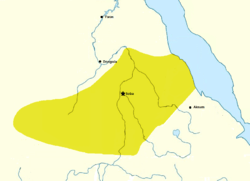Alodia
| Alodia | ||||||||||
| ||||||||||
 Approximate extension of Alodia in the 10th century | ||||||||||
| Capital | Soba | |||||||||
| Languages | Nubian | |||||||||
| Religion | Christianity | |||||||||
| Government | Monarchy | |||||||||
| Historical era | Middle Ages | |||||||||
| • | Established | 7th century | ||||||||
| • | Disestablished | 1504 | ||||||||
| ||||||||||
Alodia or Alwa was the southernmost of the three kingdoms of Christian Nubia; the other two were Nobatia and Makuria to the north.
Much about this kingdom is still unknown, despite its thousand-year existence and considerable power and geographic size. Due to fewer excavations far less is known about Alodia than its northern counterparts. Most of what is known about Christian Nubia comes from either contemporary Egyptian sources and the intensive archaeological work done in Lower Nubia prior to the flooding of many sites by the Aswan High Dam. Neither of these sources shed much light on what went on in the Upper Nubia during this period. Alodia's location in modern Sudan rather than Egypt has also hampered excavations as the greater instability of that country has long hampered work. Several literary works in Ethiopian Orthodox liturgy however point to Ethiopian control and tribute both during ancient Axumite times and during the latter Solomonic restoration. The campaigns of the twin Emperors Ezana and Sezana and their younger sibling Hadefan appear from their chronicles a retaliation for withheld tribute and continued rebellion. The inhabitants of the regions had been helping the Bejan raiders that Axum perennially fought against. Axumite records list in meticulous detail the army units dispatched, the measures taken and the numbers killed and prisoners seized in the area.
The origins of the kingdom are little known. The first reference to the Alodia might be a Meroitic stela from the reign of Nastasen, that mention a region known as Alut that might be a reference to Alodia.[1] The first concrete reference is made Pliny the Elder who includes Alwa on his list of towns in Nubia. How Alodia is related to the ancient kingdom of Meroe is one of the most important questions. Alodia was centered on what was the heart of the Meroitic empire. By the time of Ezana of Axum it seems that Alwa was controlled by the Noba rather than the Kushites.
Alodia was converted to Christianity in the 6th century by missionaries sent by Byzantine Emperor Justinian and his wife Theodora. Monophysite Christianity flourished in Alodia, more so than other Christian sects. Alodia was centered south of the great bend in the Nile river and south into the Gezira with its capital at Soba. P.L. Shennie mentions that the name of a king David, who died in 1015, was learned from a recently recovered tombstone.[2] At some points in time it seems as though Alodia and Makuria merged into one state, perhaps as a result of the close dynastic links between the two. If the two states did merge at certain times, Alodia regained its independence.

Ibn Hawqal is the most important external source on the country, being one of the only detailed first hand accounts of a traveller to the country. He describes Alodia as being larger, wealthier, and more powerful than Makuria, with the country covering a large region stretching from Ethiopia to the Kordofan.
Alodia was the farthest of the Nubian states from the influences of Egypt and thus the last of the Nubian states to be converted to Islam. The conventional date for the final destruction of Alodia is the Funj conquest of the region in the early sixteenth century. Archaeological evidence seems to show that the kingdom was in decline as early as the thirteenth century. Near the end of this century al-Harrani reports that the capital had been moved to Wayula. Later Mamluk emissaries reported that the region was divided among nine rulers.
Alodia seems to have preserved its identity after the Funj conquest and its incorporation into the Kingdom of Sennar. The Alodians, who became known as the Abdallab, revolted under Ajib the Great and formed the semi-autonomous Kingdom of Dongola that persisted for several centuries.
It may for a time have been a tributary kingdom to Axum. According to Axumite and later Ethiopian Imperial chronicles the two powers frequently clashed in the region of their borders. It would be odd that neither would record an independent polity or would not go to war with it before proceeding northward, in the case of Axum. It is a much stronger possibility that Alodia refers to a northernmost Kingdom within the Axumite Empire (or a southernmost Kingdom within the Egyptian). The former is more likely since there is ample evidence of its occurrence such as the Kingdoms of Gondar, Begemeder, Wello, Kaffa within the larger Ethiopian Empire while Egypt is more known as one whole nation, not a federated state.
Notes
- ↑ Mohi El-Din Abdalla Zarroug The Kingdom of Alwa University of Calgary Press, 1991. pg. 7
- ↑ P.L. Shinnie, Ancient Nubia (London: Kegan Paul International, 1996), p. 133.
Coordinates: 17°39′00″N 33°59′00″E / 17.6500°N 33.9833°E